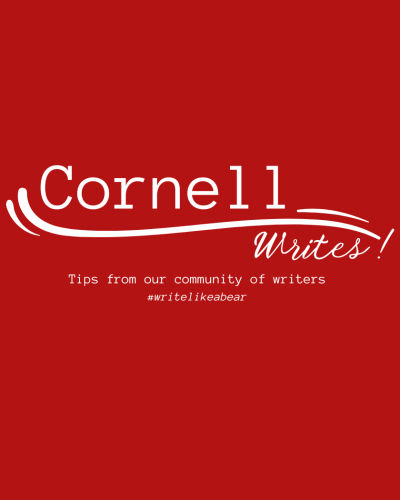Cornell Writes! Tips from our community of writers is a digital newsletter sponsored by the Knight Institute for Writing in the Disciplines and the Cornell University Graduate School.
Each week, a member of our writing community – a Graduate Writing Service, English Language Support Office, or Cornell Writing Centers tutor; a writing specialist from the Knight Institute; a writing instructor from our First-Year Writing Seminars or Writing in the Majors programs; maybe YOU – will share a writing strategy from their own writer’s toolkit. #writelikeabear
Contact Tracy Hamler Carrick with questions and ideas.
Meet Jessica Sands
Hello Cornell Writers! My name is Jessica Sands. I am the Knight Institute Writing Workshop's Multilingual Writing Specialist. My classes aim to introduce students of various language backgrounds to the cultural and academic expectations of writing in an American university and at Cornell. In addition to teaching first year writing, I also support undergraduate writers through workshops, language tutoring, and multilingual writing programs on campus.
Meet Tracy Carrick
Hello Cornell writers! My name is Tracy Carrick. I am a teacher, tutor, and director of the Knight Institute’s Writing Workshop and Graduate Writing Service. I am also a writer and editor. Right now, I am writing a conference presentation and comments on student papers.
Here is this week’s Writing Tip!
“Does my draft flow?”
Many of the writers who visit our writing centers ask this seemingly simple question – Does my draft flow? – and they are often surprised when they learn that addressing a problem with flow is rarely a quick fix. While it is true that, in the end, writers may merely move around a paragraph or two, revise a few sentences, and/or add in some metadiscourse, the process for getting to those remedies typically requires a good amount of effort and thought.
We often steer first conversations about flow toward macro-level coherence, and we work with writers to examine the ways that a writing project’s sections or body paragraphs work together and in relation to the project’s thesis, argument, or main claim. We may advise writers to create reverse outlines as a way to make visible and target possible revision areas. (See Kate Navickas’s recent Cornell Writes! post titled Reverse Outlining Gives Perspective!)
We might also zoom in to the word- or sentence-level and nudge writers to explore ways to express ideas more clearly or concisely. Since muddy expression can confuse or overwhelm readers and interfere with their ability to follow the flow of a writing project, we might shift the conversation from flow to clarity and work with writers to rewrite sentences that feature stronger subjects and more active verbs. (See Kelly King-O’Brien’s Cornell Writes! post titled Choose Stronger Verbs and Subjects!)
We also find that writers can answer questions about flow by seeking stronger cohesion at the paragraph level. In this approach, we encourage them to narrow their gaze to a single, important paragraph or two, and to contemplate the ways that the sentences within paragraphs fit together. The strategies below can help writers explore ways to develop cohesion.
Option 1 ⇒ TOPIC STRINGS ⇒ Begin sentences with known/familiar information
When forming paragraphs, choose the subjects of your sentences with intention. The subjects of your sentences should be short and concrete, and include familiar information. More often than not, your sentence subjects should be the sources of the actions of your verbs. Most important, be consistent: do not vary the subjects of your sentences for the sake of variety. The subjects of your sentences should tell readers what a passage is globally “about.”
Consider the following passage and its sentence structure. This passage is easy to read because known (previously stated) information is given before new information.
The ink of a squid is brown or black viscous fluid, which is contained in a reservoir. The ink is ejected through the siphon when a squid is alarmed. This ink not only forms an effective screen behind which the animal can escape, but it contains alkaloids that paralyze the olfactory senses of the enemy.
Here is a graphic that illustrates the key principle: In this passage, the known information in each sentence is “the ink.” This known information is used to connect the new ideas to the topic of the paragraph.
Option 2 ⇒ STITCHING ⇒ Build new information from known information
When composing a paragraph, you need to find a balance as you weigh two aims: writing clear sentences and designing a cohesive paragraph. If these two aims compete with each other, you should give priority to cohesion. Readers can forgive a clunky sentence if its larger context is solid and accessible. That means, in constructing paragraphs, you should start sentences with information with which readers are familiar.
Consider the following passage and its sentence structure. This passage is easy to read because known (previously stated) information is given before new information.
All squids propel themselves by taking in and forcibly expelling water from the mantle cavity through the siphon. The force and direction of the water expelled, plus the undulation of the fins and body, determine the direction and rapid movement of the animals. The rapid movement is always in the opposite direction of the water ejected from the siphon. The ejection of the water also oxygenates the gills, located in the mantle cavity.
Here is a graphic that illustrates the key principle: In this passage, new information in one sentence becomes known information in the next sentence. Notice how the sentences are stitched together.
__________
Admittedly, these two sample paragraphs are rather simplistic. They are models meant to illustrate two basic ways to create cohesion. Writers will likely not be able to design all paragraphs with such strict structural integrity; many paragraphs will form as blended versions with topics strings guiding some moves, and stitching others. The key take-away is this: with these tools to guide you, you can make controlled decisions about how to link sentences together to form cohesive paragraphs.
Pitfall 1 → AVOID BAND-AIDS → Use transition words only for emphasis
In reaching for cohesion, writers can sometimes overwork transition words in an effort to hold together muddled ideas. When they do, they might succeed at distracting readers from unfinished or unclear thinking, but be cautious: relying too heavily on transition words is risky.
Consider the passage below, and note its reliance on transitional words to propel the paragraph. When we remove the transition words in this passage (therefore, however, also, hence, and indeed), we can see how the writer has used transition words in an attempt to stick together otherwise disjointed sentences.
Because the press is the major medium of interaction between the president and the people, how it portrays him influences his popularity. Therefore, it should report on the president objectively. Both reporters and the president are human, however, subject to error and favoritism. Also, people act differently in public than they do in private. Hence, to understand a person, it is important to know the whole person, his environment, upbringing, and education. Indeed, from the correspondence with his family, we can learn much about Harry S. Truman, our thirty-third president. (Williams 86-87)
If you find yourself overusing transition words, you should try rewriting using the two options presented above. You might realize that you have some more thinking and writing to do in order to create cohesion for your readers and likely for yourself. After your paragraph’s implicit cohesion is clear, only then should you consider reintroducing transition words sparingly and for stylistic rather than functional purposes.
Pitfall 2 → AVOID MONOTONOUS SYNTAX → Vary sentence structure to make music
Writers can overcorrect. While it can be helpful to construct paragraphs as diagrams as we have done above, when writers get too caught up in following the formulas, they risk losing their voice and sense of style. As advised above, writers need to find balance between reaching for cohesion and composing clear and concise sentences. But it is also true that they must find a balance between composing a passage that effectively relays content and one that engages readers.
We have noticed that some writers fall into heavily patterned sentence structures when following the guidance offered here. When we too frequently repeat similar sentence structures, however, readers can become distracted by the monotony and lose track of the paragraph’s ideas. They may also lose interest. If you find yourself falling into this habit, try rewriting the paragraph again to reach for syntactic variation as Gary Provost models in this paragraph from his book 100 Ways to Improve Your Writing:
This sentence has five words. Here are five more words. Five-word sentences are fine. But several together become monotonous. Listen to what is happening. The writing is getting boring. The sound of it drones. It’s like a stuck record. The ear demands some variety. Now listen. I vary the sentence length, and I create music. Music. The writing sings. It has a pleasant rhythm, a lilt, a harmony. I use short sentences. And I use sentences of medium length. And sometimes, when I am certain the reader is rested, I will engage him with a sentence of considerable length, a sentence that burns with energy and builds with all the impetus of a crescendo, the roll of the drums, the crash of the cymbals—sounds that say listen to this, it is important.
__________
References
Provost, Gary. 100 Ways to Improve Your Writing. Berkeley, 2019.
Williams, Joseph M. “Chapter 5 Cohesion and Coherence.” Style: Lessons in Clarity and Grace, 9th ed., Longman, Boston, 2010.




